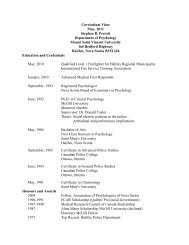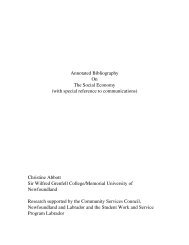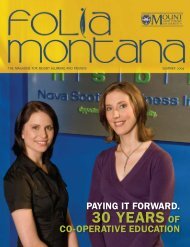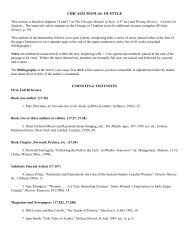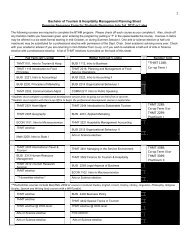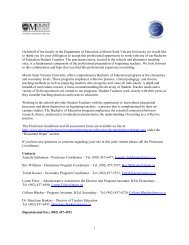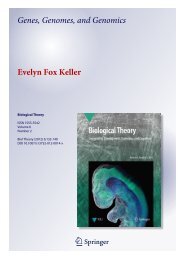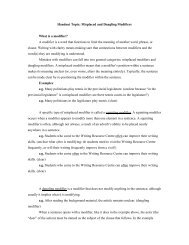Quantification of Pythium populations in ginseng soils - Mount Saint ...
Quantification of Pythium populations in ginseng soils - Mount Saint ...
Quantification of Pythium populations in ginseng soils - Mount Saint ...
You also want an ePaper? Increase the reach of your titles
YUMPU automatically turns print PDFs into web optimized ePapers that Google loves.
448applied soil ecology 40 (2008) 447–455<strong>Pythium</strong> <strong>populations</strong> <strong>in</strong> <strong>soils</strong> and plant roots have beenassessed us<strong>in</strong>g a variety <strong>of</strong> techniques. The simplest method isbased on the number <strong>of</strong> CFU formed after dilution plat<strong>in</strong>g onselective media (Jeffers and Mart<strong>in</strong>, 1986). However, thismethod is labour <strong>in</strong>tensive, does not allow for discrim<strong>in</strong>ationamong morphologically similar species, and can be h<strong>in</strong>deredby competition from other soil organisms. More sophisticatedimmunological methods, such as ELISA, have also beenemployed for <strong>Pythium</strong> quantification (Yuen et al., 1998), butthese methods are still culture dependent.More recently, real-time PCR (qPCR) has been used for thefast, accurate and culture <strong>in</strong>dependent quantification <strong>of</strong> avariety <strong>of</strong> pathogens (<strong>in</strong>clud<strong>in</strong>g <strong>Pythium</strong> spp.) from planttissues (Schaad and Frederick, 2002; Schena et al., 2004) and<strong>soils</strong> (Okubara et al., 2005; Schroeder et al., 2006; Lievens et al.,2006; Kernaghan et al., 2007). Although a variety <strong>of</strong> chemistrieshave been developed for quantitative real-time PCR (G<strong>in</strong>z<strong>in</strong>ger,2002), SYBR green <strong>in</strong>tercalat<strong>in</strong>g dyes represent the mostflexible approach to the analysis <strong>of</strong> species assemblages.Taxon specific PCR primers have been designed for a variety<strong>of</strong> <strong>Pythium</strong> species, for use <strong>in</strong> both conventional (Kageyamaet al., 1997; Wang et al., 2003) and real-time PCR reactions(Schroeder et al., 2006). In the present study, we designed PCRprimers specific to P. ultimum Trow and P. irregulare Buismansensu stricto, the two most destructive <strong>Pythium</strong> species <strong>in</strong> southwesternOntario g<strong>in</strong>seng plantations (Reeleder and Brammall,1994). P. ultimum is fairly well circumscribed both morphologicallyand genetically (Van der Plaats-Niter<strong>in</strong>k, 1981; Kageyamaet al., 2007). However, the species concept <strong>of</strong> P. irregulare iscurrently under revision (Matsumoto et al., 2000; Garzón etal.,2005, 2007) and the occurrence <strong>of</strong> morphologically similar, butgenetically divergent isolates (cryptic species) makes quantificationdifficult.Although real-time PCR quantification methods are moresensitive and specific than culture based methods (Atk<strong>in</strong>set al., 2003; Ippolito et al., 2004; Kernaghan et al., 2007), plat<strong>in</strong>gon selective media still gives valuable and complementarydata on soil pathogen <strong>populations</strong>. For example, relationshipsamong DNA concentration, microbial biomass and <strong>in</strong>fectivitymay not be equivalent across species and pathogen DNA levelsmay not necessarily be a direct <strong>in</strong>dication <strong>of</strong> <strong>in</strong>oculumpotential. The relationship between DNA concentration and<strong>in</strong>oculum potential should therefore be determ<strong>in</strong>ed empiricallyfor each pathogen species.As the ability to accurately quantify <strong>populations</strong> <strong>of</strong> <strong>Pythium</strong>species directly from <strong>soils</strong> prior to g<strong>in</strong>seng plant<strong>in</strong>g wouldallow for more accurate assessments <strong>of</strong> disease risk and areduction <strong>in</strong> the need for fumigation, we developed qPCRassays for P. irregulare and P. ultimum and used them <strong>in</strong> bothartificially <strong>in</strong>fested soil and naturally <strong>in</strong>fested g<strong>in</strong>sengcultivated<strong>soils</strong>. We also conducted concurrent estimates <strong>of</strong><strong>in</strong>oculum potential us<strong>in</strong>g counts <strong>of</strong> colony form<strong>in</strong>g units onsemi-selective agar media.2. Materials and methods2.1. Conventional PCR, sequenc<strong>in</strong>g <strong>of</strong> isolates andquantification <strong>of</strong> reference DNAIsolates <strong>of</strong> target and related species from the Southern CropProtection and Food Research Centre (SCPFRC), London, ON,and the Canadian Collection <strong>of</strong> Fungal Cultures (CCFC),Ottawa, ON (Table 1) were cultured on V8 broth. DNA wasextracted us<strong>in</strong>g the DNeasy Plant M<strong>in</strong>i Kit (Qiagen, Mississauga,ON) and the ITS 1 and 2 regions amplified on anTable 1 – Species used <strong>in</strong> this study and the results <strong>of</strong> conventional PCR (us<strong>in</strong>g primers ITS1/ITS4) and test<strong>in</strong>g <strong>of</strong> taxonspecific primersSpecies Accession # Source Conventional PCR and presence <strong>of</strong> restriction sites qPCRPiF/PiRPuF/PuRIsolates used for <strong>Pythium</strong> primer design and/or test<strong>in</strong>g<strong>Pythium</strong> heterothallicum 491 CCFC +<strong>Pythium</strong> irregulare 419 CCFC + F +P. irregulare 598 CCFC + F +P. irregulare (Group II) PID008 SCPFRC + F +<strong>Pythium</strong> paroecandrum 568 CCFC +P. irregulare (Group IV) PID018* SCPFRC +<strong>Pythium</strong> <strong>in</strong>termedium PID091* SCPFRC +<strong>Pythium</strong> splendens 435a CCFC +P. slpendens 225914 CCFC +<strong>Pythium</strong> sylvaticum 259 CCFC +<strong>Pythium</strong> ultimum 144 CCFC + B +P. ultimum 418 CCFC + B +P. ultimum PID095* SCPFRC + B +<strong>Pythium</strong> violae 400 CCFC +Isolates used for <strong>Pythium</strong> primer design onlyP. irregulare (Group II) PID003* SCPFRC + FP. irregulare (Group II) PID096* SCPFRC + FP. <strong>in</strong>termedium PID306* SCPFRC ++: Amplification <strong>of</strong> product with predicted size and melt<strong>in</strong>g temperature; : no amplification <strong>of</strong> target; *: isolates sequenced; F: presence <strong>of</strong> FspIrestriction site; B: presence <strong>of</strong> BccI restriction site.
applied soil ecology 40 (2008) 447–455 449Eppendorf Mastercycler (Br<strong>in</strong>kmann Instruments, Mississauga,ON) thermocycler <strong>in</strong> 50 mL reactions conta<strong>in</strong><strong>in</strong>g 1 UPlat<strong>in</strong>um 1 Taq DNA Polymerase, 1 PCR buffer, 200 mM dNTPmix (all from Invitrogen, Burl<strong>in</strong>gton, ON), 2.5 mM MgCl 2 , 0.8%BSA, 0.4 mM each <strong>of</strong> primers ITS 1 and ITS 4 (White et al., 1990)and 5 mL template DNA. Cycl<strong>in</strong>g parameters were 94 8C for2 m<strong>in</strong> followed by 35 cycles <strong>of</strong> 94 8C for 1 m<strong>in</strong>, 55 8C for 1 m<strong>in</strong>and 72 8C for 2 m<strong>in</strong>, followed by 72 8C for 10 m<strong>in</strong>.PCR products generated from <strong>Pythium</strong> isolates from southwesternOntario g<strong>in</strong>seng <strong>soils</strong> (PID003, PID018, PID091,PID095, PID096, PID306) (Table 1) were purified with theM<strong>in</strong>Elute PCR Purification Kit (Qiagen, Mississauga, ON) andsequenced on an ABI 377 Sequencer (Applied Biosystems,Foster City, CA) us<strong>in</strong>g BigDye 1 Term<strong>in</strong>ator chemistry(Applied Biosystems); Genbank accession numbersDQ083527–DQ083532.Reference DNA was obta<strong>in</strong>ed from fresh mycelium <strong>of</strong> P.irregulare (PID 008) and P. ultimum (PID 095) (Table 1) byextract<strong>in</strong>g with the DNeasy Plant M<strong>in</strong>i Kit (Qiagen) andquantify<strong>in</strong>g with an Eppendorf BioPhotometer calibratedwith calf thymus DNA (Sigma) <strong>in</strong> Qiagen elution buffer(buffer AE).2.2. Design <strong>of</strong> taxon specific primers and identification <strong>of</strong>specific restriction sitesTaxon specific primer pairs target<strong>in</strong>g the <strong>in</strong>ternallytranscribed spacer regions <strong>of</strong> P. irregulare Groups I and II(sensu Matsumoto et al., 2000) (PiF 5 0 -GTAGCATGCGT-GTTTGCTTA-3 0 /PiR 5 0 -GCAAGCTGTGCATTCATTGC-3 0 ) andP. ultimum (PuF 5 0 -ATGATGGACTAGCTGATGAA-3 0 /PuR 5 0 -TTCCATTACACTTCATAGAA-3 0 )weredesignedonthebasis<strong>of</strong> an alignment <strong>of</strong> sequenced SCPFRC and CCFC <strong>Pythium</strong>cultures and over 100 <strong>Pythium</strong> sequences from Genbankus<strong>in</strong>g BioEdit ver. 7.0.0 (Hall, 1999). The predicted PCRproduct sizes were 508 and 407 bp, respectively. The extent<strong>of</strong> primer dimer formation was predicted us<strong>in</strong>g thePrimerSelect module <strong>of</strong> DNASTAR (Madison, WI). Specificity<strong>of</strong> real-time amplifications was tested on a Roche DiagnosticsLightCycler 1, us<strong>in</strong>g DNA extracted from a range <strong>of</strong>related <strong>Pythium</strong> species, previously isolated from g<strong>in</strong>seng<strong>soils</strong> (Table 1).In order to confirm target amplification from soil, thealignment <strong>of</strong> <strong>Pythium</strong> species used for taxon specific primerdesign was also used to identify restriction sites whichcould dist<strong>in</strong>guish between the amplified DNA <strong>of</strong> our targetspecies and that <strong>of</strong> other <strong>Pythium</strong> species from naturally<strong>in</strong>fested <strong>soils</strong>. Restriction digests <strong>of</strong> the ITS region withenzymes FspI and BccI were predicted to result <strong>in</strong> restrictiondigestion patterns characteristic <strong>of</strong> P. irregulare Groups I andII (sensu Matsumoto et al., 2000) andP. ultimum, respectively.To test for the presence <strong>of</strong> these restriction sites, digests <strong>of</strong>PCR products generated from 17 <strong>Pythium</strong> isolates byconventional PCR (Table 1) were carried out by comb<strong>in</strong><strong>in</strong>g10 mL <strong>of</strong>PCRproductwith5U<strong>of</strong>eitherFspIorBccI(NewEngland Biolabs, Picker<strong>in</strong>g, Ontario), 2 mL <strong>of</strong> 10 reactionbuffer and 7 mL H 2 O. Reactions were <strong>in</strong>cubated at 37 8C for3 h, separated electrophoretically on 2% agarose <strong>in</strong> TAEbuffer and analyzed with the Gel Doc EQ System (Bio-Rad,Hercules, CA).2.3. Collection and preparation <strong>of</strong> soilArtificially <strong>in</strong>fested soil was prepared us<strong>in</strong>g Fox loamy sand(Brunosolic Gray Brown Luvisol; Typic Hapludalf; 0.9% OM)from the Agriculture and Agri-food Canada research farm atDelhi, Ontario (42847 0 N, 80838 0 W). Soil was steam pasteurizedat 74 8C for 30 m<strong>in</strong> us<strong>in</strong>g a L<strong>in</strong>dig soil treatment system (L<strong>in</strong>digManufactur<strong>in</strong>g, St. Paul, MN), air-dried, sieved through a 4 mmmesh, mixed and stored at room temperature until used. Soildilution (1 part soil <strong>in</strong> 4 parts 0.25% water agar) procedureswere carried out us<strong>in</strong>g P 5 ARP semi-selective media (Jeffers andMart<strong>in</strong>, 1986; Reeleder et al., 2006b) to confirm that pasteurizationhad elim<strong>in</strong>ated viable propagules. P. irregulare (PID008)and P. ultimum (PID095) were grown for 2 weeks <strong>in</strong> clarified V8broth. Twenty mycelial mats were then washed with sterilewater and vacuum filtration, macerated us<strong>in</strong>g autoclavedm<strong>in</strong>i-blenders and re-suspended <strong>in</strong> approx. 240 mL sterilewater. Macerates were mixed <strong>in</strong>to pasteurized soil atapproximately 40 mL/kg soil <strong>in</strong> a large plastic bag and mixedby vigorously shak<strong>in</strong>g, then allow<strong>in</strong>g the mixed soil to air dry.The result<strong>in</strong>g <strong>in</strong>oculum was then further mixed withpasteurized field soil <strong>in</strong> different proportions. The result<strong>in</strong>gsoil dilutions were 100, 50, 10 and 1%. Each dilution was thendivided <strong>in</strong>to six sub-samples, air dried <strong>in</strong> the greenhouse andstored at 4 8C until plat<strong>in</strong>g and DNA extraction.Samples <strong>of</strong> naturally <strong>in</strong>fested <strong>soils</strong> (rang<strong>in</strong>g from sands tosandy loams) were collected at seven sites <strong>in</strong> south-westernOntario. At each site, one 441 m 2 plot was constructed anddivided <strong>in</strong>to 49.9 m 2 quadrats. Approx. 2 L <strong>of</strong> topsoil wasremoved from each quadrat. Sampl<strong>in</strong>g locations wererecorded by GPS. Soil samples from with<strong>in</strong> each site werepooled, passively air dried at room temperature, mixed with acommercial cement mixer, sieved, and mixed aga<strong>in</strong>. Allequipment, <strong>in</strong>clud<strong>in</strong>g mixer and sieve were sterilized withhousehold bleach (diluted with water to 0.5% sodium hypochlorite)between <strong>soils</strong>. Soils were placed <strong>in</strong> plastic bags andstored at 4 8C until used. DNA was extracted and purified from5 g subsamples <strong>of</strong> each artificially and naturally <strong>in</strong>fested soilas described <strong>in</strong> Kernaghan et al. (2007).2.4. qPCRqPCR was performed on extracts <strong>of</strong> samples <strong>of</strong> the artificially<strong>in</strong>fested soil us<strong>in</strong>g SYBR green chemistry on a RocheDiagnostics Light Cycler TM I. Twenty microlitres reactionmixtures were prepared <strong>in</strong> glass capillaries (Roche Diagnostics)and <strong>in</strong>cluded 2 mL soil DNA extract, 9.8 mL Quanti-Tect SYBR Green PCR Master Mix (Qiagen), 0.1 U HotStarTaqDNA Polymerase (Qiagen) and 0.6 mM each <strong>of</strong> primers PiFand PiR or PuF and PuR. Reactions us<strong>in</strong>g PuF/PuR received1mM MgCl 2 <strong>in</strong> addition to the 2.5 mM present <strong>in</strong> theQuantiTect Master Mix.For each primer pair, PCR reactions were carried out onDNA extractions from each <strong>of</strong> the six subsamples taken fromeach soil dilution, as well as on a dilution series <strong>of</strong> referenceDNA (Quantified DNA from pure culture) and the negative(yeast) control extract. All reactions received a 15 m<strong>in</strong> pretreatmentat 95 8C, then 60 cycles <strong>of</strong> 94 8C for 15 s, 64 8C for 15 s,72 8C for 25 s for the PiF/PiR primer set and 94 8C for 15 s, 54 8Cfor 30 s, 72 8C for 35 s for the PuF/PuR primer set. For all
450applied soil ecology 40 (2008) 447–455reactions, temperature transition rates were 20 8C/s and thefluorescent signal was acquired at 72 8C. After cycl<strong>in</strong>g, melt<strong>in</strong>gcurves were generated by <strong>in</strong>creas<strong>in</strong>g the temperature from 65to 95 8C at a rate <strong>of</strong> 0.1 8C/s with cont<strong>in</strong>uous acquisition <strong>of</strong> thefluorescent signal.For the naturally <strong>in</strong>fested <strong>soils</strong>, qPCR was carried out as forartificially <strong>in</strong>fested <strong>soils</strong>, except that each crude DNA extract(one from each <strong>of</strong> four subsamples <strong>of</strong> each <strong>of</strong> the seven <strong>soils</strong>)was split <strong>in</strong>to three parallel extraction replicates after the firstcentrifugation and prior to purification and amplification. Thisallowed for <strong>in</strong>creased precision <strong>in</strong> situations with very lowlevels <strong>of</strong> target DNA.2.4.1. Post amplification characterization <strong>of</strong> qPCR productsqPCR products amplified from soil extracts were run onagarose gels and sta<strong>in</strong>ed with ethidium bromide to confirm theproduct size. For each soil sample which successfullyamplified us<strong>in</strong>g either primer set, one <strong>of</strong> the amplicons fromthe three parallel extractions for that sample was restrictedwith either FspI or Bcc I (as above), to further confirm theidentity <strong>of</strong> the amplified DNA. One real-time ampliconproduced with each primer set, was also randomly selectedand sequenced.2.4.2. Analysis <strong>of</strong> qPCR dataqPCR data generated by the light cycler was analyzed us<strong>in</strong>gL<strong>in</strong>RegPCR s<strong>of</strong>tware (Ramakers et al., 2003). For each set <strong>of</strong> PCRreactions (each Light Cycler carousel) the logarithms <strong>of</strong> the<strong>in</strong>itial fluorescence (N 0 calculated by L<strong>in</strong>RegPCR) for the serialdilutions <strong>of</strong> quantified reference DNA were plotted aga<strong>in</strong>st thelogarithms <strong>of</strong> their actual DNA concentrations. The equation<strong>of</strong> the result<strong>in</strong>g l<strong>in</strong>e was then used to estimate the <strong>in</strong>itialconcentration <strong>of</strong> target DNA templates from the soil samples.This approach does not require (or assume) equal PCRamplification efficiencies and accounts for any variation <strong>in</strong>amplification efficiency among sets <strong>of</strong> PCR reactions(Ramakers et al., 2003).2.5. Dilution plat<strong>in</strong>gThe number <strong>of</strong> colony form<strong>in</strong>g units per gram dry soil wasdeterm<strong>in</strong>ed for both artificially and naturally <strong>in</strong>fested <strong>soils</strong>us<strong>in</strong>g P 5 ARP soil dilution plates as described above, but us<strong>in</strong>gsoil:water agar dilutions <strong>of</strong> 1:10 and 1:100. Three 10 g aliquots<strong>of</strong> each soil were oven-dried at 104 8C for 3 days. Oven-dryweights were used to determ<strong>in</strong>e soil moisture; plate countdata were then adjusted to a CFU per g dry soil basis. Isolates <strong>of</strong><strong>Pythium</strong> spp. from each field were identified morphologicallyon the basis <strong>of</strong> Middleton (1952), Waterhouse (1967) and Vander Plaats-Niter<strong>in</strong>k (1981). Pearson correlations between theresult<strong>in</strong>g CFU data and the qPCR data were calculated <strong>in</strong> SPSSrelease 13.0 (SPSS Inc. Chicago, IL) us<strong>in</strong>g non-transformeddata.2.6. Sequenc<strong>in</strong>g <strong>of</strong> dilution plate coloniesDue to the presence <strong>of</strong> cryptic species <strong>in</strong> the P. irregularecomplex, not all <strong>of</strong> the isolates morphologically identified asP. irregulare possessed the PiF/PiR primer sites and wouldtherefore not be detected by our assay. In order to correlateour qPCR and CFU data sets from naturally <strong>in</strong>fested <strong>soils</strong>, itwas necessary to determ<strong>in</strong>e the proportion <strong>of</strong> colonyform<strong>in</strong>g units that possessed PiF/PiR primer sites and adjustthe qPCR data for P. irregulare from naturally <strong>in</strong>fested <strong>soils</strong>accord<strong>in</strong>gly. Representative dilution plate colonies morphologicallyidentified as P. irregulare were sequenced us<strong>in</strong>g theprimer sets ITS1/ITS4 or ITS5/ITS4 (White et al., 1990) asdescribed above. The 83 result<strong>in</strong>g ITS sequences were thenaligned with reference sequences from Genbank us<strong>in</strong>gClustal X (Thompson et al., 1997) and then manuallyadjusted us<strong>in</strong>g Bioedit (Ver. 5.0.6) (Hall, 1999). Maximumparsimony analysis was then performed us<strong>in</strong>g PAUP* version4beta 10 (Swafford, 1998) withPhytopthora c<strong>in</strong>namomi Randsas an outgroup, TBR branch swapp<strong>in</strong>g and 100 bootstrapreplications.3. Results3.1. Specificity <strong>of</strong> qPCR primersqPCR us<strong>in</strong>g the taxon specific primer pairs PiF/PiR and PuF/PuRon P. irregulare (PID008) and P. ultimum (PID095) DNA from purecultures (at between 100 and 1 pg/mL extract) producedamplicons with melt<strong>in</strong>g po<strong>in</strong>ts at 87.5 and 82.3 8C, respectively.The melt<strong>in</strong>g pr<strong>of</strong>iles <strong>of</strong> P. irregulare amplicons also<strong>in</strong>cluded a secondary peak at 82 8C, likely due to a highly ATrich region <strong>in</strong> the center <strong>of</strong> the amplicon (see Li et al., 2003).This melt<strong>in</strong>g pr<strong>of</strong>ile is also predicted by the analysis <strong>of</strong> P.irregulare ITS sequences us<strong>in</strong>g the Poland algorithm (Steger,1994). Post amplification gel electrophoresis also revealed thatall amplicons were <strong>of</strong> the predicted sizes. Average PCRefficiencies, calculated us<strong>in</strong>g L<strong>in</strong>RegPCR (Ramakers et al.,2003), were 1.51 and 1.68 (<strong>of</strong> a maximum possible value <strong>of</strong> 2.0)respectively.Test<strong>in</strong>g <strong>of</strong> the two primer pairs aga<strong>in</strong>st a range <strong>of</strong> relatedspecies <strong>in</strong>dicated that they were highly specific under theamplification parameters used. Only DNA from P. irregulare(Groups I and II) and P. ultimum resulted <strong>in</strong> qPCR ampliconsus<strong>in</strong>g PiF/PiR and PuF/PuR, respectively (Table 1). All DNAextracts tested produced conventional PCR products us<strong>in</strong>g thenon-specific primers ITS1/ITS4 (White et al., 1990), <strong>in</strong>dicat<strong>in</strong>gthe presence <strong>of</strong> amplifiable templates.3.2. Specificity <strong>of</strong> restriction digestsFspI and BccI digests <strong>of</strong> conventional PCR products generatedfrom 17 <strong>Pythium</strong> isolates us<strong>in</strong>g primers ITS1–ITS4 (Table 1)resulted <strong>in</strong> characteristic restriction fragment patterns for P.irregulare (Groups I and II) and P. ultimum, respectively. Therestriction patterns clearly dist<strong>in</strong>guished the two targetamplicons from each other and from those <strong>of</strong> all other <strong>Pythium</strong>species tested (Fig. 1).Although the taxon specific primers used for qPCRamplification <strong>of</strong> the target <strong>Pythium</strong> species (PiF/PiR and PuF/PuR) are <strong>in</strong>ternal to the ITS primers used for the conventionalPCR, one characteristic restriction site was still present <strong>in</strong> each<strong>of</strong> the qPCR amplicons, allow<strong>in</strong>g us to confirm targetamplification by digest<strong>in</strong>g the qPCR products with FspI andBccI.
applied soil ecology 40 (2008) 447–455 451the same melt<strong>in</strong>g pr<strong>of</strong>iles as those from pure culture. Gelelectrophoresis <strong>of</strong> the qPCR amplicons produced with the twoprimer sets revealed that they were all <strong>of</strong> the predicted size.Restriction digests us<strong>in</strong>g BccI and FspI also <strong>in</strong>dicated that thetarget DNA had been amplified. Restriction <strong>of</strong> the 508 bp P.irregulare (Groups I and II sensu Matsumoto et al., 2000)amplicons with FspI resulted <strong>in</strong> fragments <strong>of</strong> 450 and 50 bp,whereas restriction <strong>of</strong> the 407 bp P. ultimum amplicons withBccI resulted <strong>in</strong> fragments <strong>of</strong> 290 and 120 bp. Sequences <strong>of</strong>randomly selected real-time amplicons produced us<strong>in</strong>g thetwo primer sets also aligned well with sequences derived frompure culture.3.4. Colony form<strong>in</strong>g unitsFig. 1 – Restriction digests <strong>of</strong> conventional PCR ampliconsfrom 17 <strong>Pythium</strong> isolates demonstrat<strong>in</strong>g the characteristicrestriction sites <strong>in</strong> P. irregulare (Groups I and II) and P.ultimum. (a) BccI digestion discrim<strong>in</strong>at<strong>in</strong>g P. irregulare(Groups I and II). (b) FspI digestion discrim<strong>in</strong>at<strong>in</strong>g P.ultimum. For both gels, lanes 1 and 12, 100 bp size marker;lanes 2, 5 and 17, P. ultimum; lanes 6, 10, 13, 14 and 18, P.irregulare (Groups I and II); lanes 7 and 11, P. splendens;lanes 16 and 19, P. <strong>in</strong>termedium; lane 3, P. sylvaticum; lane4, P. violae; lane 8, P. heterothallicum; lane 9, P.parocandrum; lane 15, P. irregulare (Group IV). Lanenumbers correspond<strong>in</strong>g to pr<strong>of</strong>iles <strong>of</strong> qPCR targets areunderl<strong>in</strong>ed.3.3. qPCR <strong>of</strong> DNA extracted from <strong>soils</strong>qPCR amplification from the <strong>soils</strong> artificially <strong>in</strong>oculated withthe two <strong>Pythium</strong> species resulted <strong>in</strong> amplicons <strong>of</strong> the same sizeand melt<strong>in</strong>g temperatures as those from pure culture. PCRefficiencies <strong>of</strong> reactions us<strong>in</strong>g templates derived from artificially<strong>in</strong>oculated soil were also very similar to those from pureculture. Average target DNA concentrations for P. irregulareDNA ranged from 13.7 pg/mL 2.42 <strong>in</strong> the soil <strong>in</strong>oculated at100% to .04 pg/mL .01 <strong>in</strong> the soil <strong>in</strong>oculated at 1% and P.ultimum ranged from 19.51 pg/mL .52 to .43 pg/mL .23.PCR efficiencies <strong>of</strong> amplifications from naturally <strong>in</strong>fested soilextracts were also very similar to those from pure culture, andaga<strong>in</strong> resulted <strong>in</strong> amplicons <strong>of</strong> the predicted size. However,amplification <strong>of</strong> extracts from the fourth set <strong>of</strong> subsamplesus<strong>in</strong>g the PiF/PiR primer set exhibited very poor PCR efficiency,perhaps due to prolonged storage <strong>of</strong> the soil samples. Data fromthis replication were not <strong>in</strong>cluded <strong>in</strong> the analyses.Average concentrations <strong>of</strong> P. irregulare DNA ranged from3.7 10 5 pg/mL soil extract 4.5 10 5 (SE) <strong>in</strong> soil G, to.04 pg/mL .03 <strong>in</strong> soil F. P. ultimum DNA ranged from .21 pg/mL .05 <strong>in</strong> soil C to 1.2 pg/mL .57 <strong>in</strong> soil G.3.3.1. Post-amplification characterization <strong>of</strong> qPCR productsfrom soilqPCR amplification <strong>of</strong> the two <strong>Pythium</strong> species pathogenspecies from the naturally <strong>in</strong>fested <strong>soils</strong> aga<strong>in</strong> resulted <strong>in</strong>Plat<strong>in</strong>g <strong>of</strong> <strong>soils</strong> artificially <strong>in</strong>oculated with either P. irregulare orP. ultimum onto P 5 ARP media gave average CFU counts rang<strong>in</strong>gfrom 42.5 3.6 propagules/100 mg dry soil <strong>in</strong> the 100%<strong>in</strong>fested (non-diluted) soil to 8.7 2.1 <strong>in</strong> the most diluted soil(1% <strong>in</strong>oculum) and from 62.1 7.4 to 7.9 .55 propagules/100 mg dry soil, respectively.Plat<strong>in</strong>g <strong>of</strong> the naturally <strong>in</strong>fested <strong>soils</strong> onto P 5 ARP mediaresulted <strong>in</strong> average P. irregulare CFU counts (based onmorphology) rang<strong>in</strong>g from 23.4 3.7 (SE) propagules/100 mgdry soil <strong>in</strong> soil E, to 3.6 1.1 propagules/100 mg dry soil <strong>in</strong> soilA. P. ultimum CFU counts ranged from 14.9 3.1 <strong>in</strong> soil E to.62 .36 <strong>in</strong> soil D.3.5. Analysis <strong>of</strong> sequences derived from dilution platesThe maximum parsimony analysis <strong>of</strong> the P. irregulare ITSsequences obta<strong>in</strong>ed from the colonies grow<strong>in</strong>g on P 5 ARPdilution plates clearly divided the colonies <strong>in</strong>to two groups;those which possessed the PiF/PiR primer sites and thosewhich did not (Fig. 2). Overall 64% <strong>of</strong> the P. irregulare isolatessequenced conta<strong>in</strong>ed the qPCR primer sites and would havebeen detectable by our qPCR assay. Proportions <strong>of</strong> isolateswhich possessed the primer sites ranged from 10% <strong>in</strong> soil G to100% <strong>in</strong> soil A (Fig. 3).3.6. Comparison <strong>of</strong> qPCR and CFU measures <strong>of</strong> <strong>Pythium</strong><strong>populations</strong>In the <strong>soils</strong> artificially <strong>in</strong>fested with either P. irregulare or P.ultimum, both the DNA concentrations and CFU countsdecreased with <strong>in</strong>creas<strong>in</strong>g <strong>in</strong>oculum dilution. The changes<strong>in</strong> the two measures were positively correlated (Pearsoncorrelation) with r = .998, p = .011, n = 4 for P. irregulare andr = .974, p = .026, n = 4 for P. ultimum.However, the relationship between measured pathogenconcentration and soil dilution was much stronger for DNAmeasures than for CFU (Fig. 4). In the case <strong>of</strong> P. ultimum a l<strong>in</strong>earregression <strong>of</strong> DNA concentration on <strong>in</strong>oculum dilution (notshown) gives r 2 = .980; p = .001, while CFU on <strong>in</strong>oculumdilution gives r 2 = .921; p = .040.Concentrations <strong>of</strong> <strong>Pythium</strong> DNA were also positivelycorrelated with CFU counts <strong>in</strong> the seven naturally <strong>in</strong>fested<strong>soils</strong>; r = .761, p = .046, n = 7 for P. irregulare (after correction forpresence/absence <strong>of</strong> qPCR primer sites) and r = .931, p = .002,n = 7 for P. ultimum. However, the CFU data <strong>in</strong>dicates that the
452applied soil ecology 40 (2008) 447–455Fig. 2 – One <strong>of</strong> the most parsimonious trees based on the ITS sequences from 83 colonies from seven g<strong>in</strong>seng <strong>soils</strong> (A–G),isolated on selective media and morphologically identified as <strong>Pythium</strong> irregulare (labeled with a PID number). Consistency<strong>in</strong>dex (CI) = 0.876, rescaled consistency <strong>in</strong>dex (RCI) = 0.852, retention <strong>in</strong>dex (RI) = 0.972. Isolates <strong>in</strong> the upper clade possessthe PiF/PiR prim<strong>in</strong>g sites and are therefore detectable by the real-time PCR assay. Reference sequences from Genbank andbootstrap values above 70% are <strong>in</strong>cluded.
applied soil ecology 40 (2008) 447–455 453Fig. 3 – Percentages <strong>of</strong> P. irregulare colonies possess<strong>in</strong>g PiF/PiR qPCR primer sites (black) <strong>in</strong> each <strong>of</strong> the seven naturally<strong>in</strong>fested <strong>soils</strong>. Data based on ITS sequences <strong>of</strong> dilutionplate colonies obta<strong>in</strong>ed us<strong>in</strong>g universal primers. Thenumber <strong>of</strong> colonies sequenced per soil is given at the top<strong>of</strong> each bar.Fig. 5 – Target DNA concentrations (black) compared to CFUdata (grey) <strong>in</strong> each <strong>of</strong> the seven naturally <strong>in</strong>fested <strong>soils</strong>. (a)P. irregulare DNA VS CFU/100 mg dry soil; CFU dataadjusted to reflect the proportion <strong>of</strong> isolates possess<strong>in</strong>gqPCR primer sites. (b) P. ultimum DNA VS CFU/100 mg drysoil. Each bar represents an average <strong>of</strong> threemeasurements. Error bars represent the standard error <strong>of</strong>the mean.naturally occurr<strong>in</strong>g P. irregulare <strong>populations</strong> are somewhathigher than those <strong>of</strong> P. ultimum, while the average concentration<strong>of</strong> P. irregulare DNA was much lower than that <strong>of</strong> P. ultimumDNA (Fig. 5).4. DiscussionFig. 4 – Target DNA concentrations compared to numbers <strong>of</strong>colony form<strong>in</strong>g units <strong>in</strong> dilution series <strong>of</strong> artificially<strong>in</strong>fested <strong>soils</strong>. (a) <strong>Pythium</strong> irregulare DNA VS P. irregulareCFU/100 mg dry soil. (b) <strong>Pythium</strong> ultimum DNA VS P.ultimum CFU/100 mg dry soil. Error bars represent thestandard error <strong>of</strong> the mean.We have used both real-time PCR and dilution plat<strong>in</strong>g onselective media <strong>in</strong> order to estimate <strong>populations</strong> <strong>of</strong> P. irregulareand P. ultimum <strong>in</strong> g<strong>in</strong>seng <strong>soils</strong> <strong>in</strong> south-western Ontario. Ingeneral, there was good agreement between the data setsproduced us<strong>in</strong>g the two techniques. However, the directcomparison <strong>of</strong> qPCR and dilution plate data proved difficult forP. irregulare, due to the presence <strong>of</strong> cryptic species with<strong>in</strong> the‘‘P. irregulare complex’’ (Garzón et al., 2007).Our qPCR primers for P. irregulare were designed to targetthe most common members <strong>of</strong> the P. irregulare complex;essentially those def<strong>in</strong>ed by Matsumoto et al. (2000) as ‘‘GroupI’’ and ‘‘Group II’’ and more recently by Garzón et al. (2005) as P.irregulare sensu stricto. However, sequences from P. irregulare
454applied soil ecology 40 (2008) 447–455colonies formed on P 5 ARP <strong>in</strong>dicated the presence <strong>of</strong> another,morphologically similar but less common, stra<strong>in</strong> <strong>of</strong> P.irregulare, which does not possess our primer sites (geneticallysimilar to ‘‘Group IV’’ <strong>of</strong> Matsumoto et al., 2000). This resulted<strong>in</strong> overestimations <strong>of</strong> colony form<strong>in</strong>g units with respect to thestra<strong>in</strong>s targeted by our qPCR primers. This problem wasovercome by further sequenc<strong>in</strong>g <strong>of</strong> isolates from the dilutionplates and perform<strong>in</strong>g maximum parsimony analysis (Fig. 3)todeterm<strong>in</strong>e the <strong>in</strong>traspecific placement <strong>of</strong> each isolate. Theproportion <strong>of</strong> isolates detectable by our qPCR assay was thencalculated for each soil, and the dilution plate data correctedaccord<strong>in</strong>gly.The maximum parsimony tree clearly divides the isolatesrecovered from the dilution plates <strong>in</strong>to two groups. Theupper clade, the members <strong>of</strong> which possess our qPCR primersites, is equivalent to ‘‘Group I’’ and ‘‘Group II’’ <strong>of</strong>Matsumoto et al. (2000), whilethelowercladeisanalogousto their ‘‘Group IV’’. We did not detect any members <strong>of</strong>‘‘Group III’’ <strong>in</strong> our <strong>soils</strong>. The upper clade <strong>of</strong> Fig. 3 is alsoanalogous to the ‘‘P. irregulare sensu stricto’’ clade <strong>of</strong> Garzónet al. (2005), while the lower clade is analogous to their ‘‘P.irregulare sensu lato’’. Garzón et al. (2007) have also proposeda new species with<strong>in</strong> the P. irregulare complex on the basis <strong>of</strong>ITS and cox II sequences as well as AFLP data. These isolatesform the uppermost subclade <strong>of</strong> our tree and representapproximately 6% <strong>of</strong> the dilution plate isolates sequenced.On the basis <strong>of</strong> the above phylogentic analyses, it seemslikely that other new species will soon be del<strong>in</strong>eated with<strong>in</strong>the P. irregulare complex.The proportions <strong>of</strong> the two P. irregulare types differedgreatly across the seven <strong>soils</strong> analyzed, with four be<strong>in</strong>gdom<strong>in</strong>ated by isolates with our primer sites and threedom<strong>in</strong>ated by isolates without our primer sites (Fig. 4).Although there is no obvious reason for this variation, the<strong>soils</strong> do vary somewhat <strong>in</strong> soil characteristics and cropp<strong>in</strong>ghistories (see Kernaghan et al., 2007).Although pathogen DNA concentrations and CFU countswere positively correlated <strong>in</strong> both the artificially and naturally<strong>in</strong>fested <strong>soils</strong>, the range <strong>of</strong> DNA concentrations for P. ultimum<strong>in</strong> the naturally <strong>in</strong>fested <strong>soils</strong> was much lower than that <strong>of</strong> P.irregulare, even though the range <strong>of</strong> CFU counts for the twospecies was similar (Fig. 5). Reasons for this discrepancy may<strong>in</strong>clude differences <strong>in</strong> extraction efficiency, or a highergerm<strong>in</strong>ation rate <strong>of</strong> propagules produced by P. irregularerelative to those <strong>of</strong> P. ultimum. This is supported by thedifferences <strong>in</strong> the DNA:CFU ratios for the artificially <strong>in</strong>fested<strong>soils</strong> (Fig. 2), <strong>in</strong> which both the DNA and CFU values for P.ultimum <strong>in</strong>fested <strong>soils</strong> decrease rapidly with soil dilution, whileCFU counts from P. irregulare <strong>in</strong>fested <strong>soils</strong> rema<strong>in</strong> fairly high,relative to DNA concentrations, over the dilution series. Also,P. irregulare grew more rapidly on the selective medium usedand may have masked the presence <strong>of</strong> P. ultimum colonies <strong>in</strong>some cases, result<strong>in</strong>g <strong>in</strong> an underestimate <strong>of</strong> P. ultimumcolonies.Another possible explanation for differences <strong>in</strong> theDNA:CFU ratios between the two pathogens may lie <strong>in</strong>differences between the copy number <strong>of</strong> the ribosomal DNAgene clusters (which <strong>in</strong>cludes the targeted ITS region) pernucleus, which would result <strong>in</strong> differences among calculatedDNA concentration to biomass ratios across species (Atk<strong>in</strong>set al., 2003). In fungi, rDNA gene cluster copy numbers havebeen estimated at approximately 100 per cell <strong>in</strong> Cochliobolusheterostrophus (Drechsler) Drechsler (Tsuchiya and Taga, 2001),and found to vary up to 400% among isolates <strong>of</strong> Glomus<strong>in</strong>traradices Schenk & Smith (Corradi et al., 2006). Althoughnumbers <strong>of</strong> rDNA copies per nucleus have not been determ<strong>in</strong>edfor Oomycetes, it is likely that variation <strong>in</strong> the number<strong>of</strong> rDNA repeats per nucleus will affect the ratio betweencalculated DNA concentrations and the actual concentration<strong>of</strong> the pathogen <strong>in</strong> the soil.The difference between the ratio <strong>of</strong> calculated DNAconcentration to the number <strong>of</strong> colony form<strong>in</strong>g units <strong>in</strong> P.irregulare and P. ultimum exemplifies the need for caution whenattempt<strong>in</strong>g to <strong>in</strong>fer disease risk directly from pathogen DNAconcentrations.Taken alone, data on soil pathogen DNA concentrations areuseful for relative comparisons across samples, but do notnecessarily reflect fungal biomass, viability or <strong>in</strong>oculumpotential. However, if a consistent relationship betweenDNA concentration and the number <strong>of</strong> colony form<strong>in</strong>g unitson selective media can be established, then data on DNAconcentration can be used as a faster and more accurate proxyfor the more time consum<strong>in</strong>g culture based assessments <strong>of</strong><strong>in</strong>oculum potential.Although the <strong>in</strong>cidence <strong>of</strong> disease will also depend uponplant susceptibility (e.g. seedl<strong>in</strong>g age), as well as on localenvironmental conditions, estimations <strong>of</strong> soil <strong>in</strong>oculumpotentials by real-time PCR (after calibration by dilutionplat<strong>in</strong>g) will improve the speed and accuracy <strong>of</strong> disease riskassessment and help to reduce unnecessary pesticideapplication.AcknowledgementsFund<strong>in</strong>g for this project was supplied <strong>in</strong> part by the Match<strong>in</strong>gInvestment Initiatives Program <strong>of</strong> Agriculture and Agri-FoodCanada, the Ontario G<strong>in</strong>seng Growers Association, and theAssociated G<strong>in</strong>seng Growers <strong>of</strong> British Columbia.B. Capell, J. Miller, G. Patriqu<strong>in</strong>, M. Pelletier and Y. Zhangprovided technical assistance.referencesAgriculture and Agri-Food Canada, 2003. G<strong>in</strong>seng Statistics.http://www.agr.gc.ca/misb/spcrops/sccs_e.php?section=stats&page=g<strong>in</strong>seng.Atk<strong>in</strong>s, S.D., Clark, I.M., Sosnowska, D., Hirsch, P.R., Kerry, B.R.,2003. Detection and quantification <strong>of</strong> Plectosphaerellacucumer<strong>in</strong>a, a potential biological control agent <strong>of</strong> potatocyst nematodes, by us<strong>in</strong>g conventional PCR, real-time PCR,selective media, and bait<strong>in</strong>g. Appl. Environ. Microbiol. 69,4788–4793.Corradi, N., Croll, D., Colard, A., Kuhn, G., Eh<strong>in</strong>ger, M., Sanders,I.R., 2006. Gene copy number polymorphisms <strong>in</strong> anarbuscular mycorrhizal fungal population. Appl. Environ.Microbiol. 73, 366–369.Garzón, C.D., Geiser, D.M., Moorman, G.W., 2005. Amplifiedfragment length polymorphism analysis and <strong>in</strong>ternaltranscribed spacer and coxII sequences reveal a species
applied soil ecology 40 (2008) 447–455 455boundary with<strong>in</strong> <strong>Pythium</strong> irregulare. Phytopathology 95,1489–1498.Garzón, C.D., Yánezand, J.M., Moorman, G.W., 2007. <strong>Pythium</strong>cryptoirregulare, a new species with<strong>in</strong> the P. irregularecomplex. Mycologia 99, 291–301.G<strong>in</strong>z<strong>in</strong>ger, D.G., 2002. Gene quantification us<strong>in</strong>g real-timequantitative PCR: an emerg<strong>in</strong>g technology hits thema<strong>in</strong>stream. Exp. Hematol. 30, 503–512.Hall, T.A., 1999. BioEdit: a user-friendly biological sequencealignment editor and analysis program for W<strong>in</strong>dows 95/98/NT. Nucl. Acids Symp. Ser. 41, 95–98.Howard, R.J., Garland, J.A., Seaman, W.L., 1994. Diseases andPests <strong>of</strong> Vegetable Crops <strong>in</strong> Canada. CanadianPhytopathological Society and Entomological Society <strong>of</strong>Canada, Ottawa, Ontario, 554 pp.Ippolito, A., Schena, L., Nigro, F., Ligorio, V.S., Yaseen, T., 2004.Real-time detection <strong>of</strong> Phytophthora nicotianae and P.citrophthora<strong>in</strong> citrus roots and soil. Eur. J. Plant Pathol. 110,833–843.Jeffers, S.N., Mart<strong>in</strong>, S.B., 1986. Comparison <strong>of</strong> two mediaselective for Phytophthora and <strong>Pythium</strong> species. Plant Dis. 70,1038–1043.Kageyama, K., Ohyama, A., Hyakumachi, M., 1997. Detection <strong>of</strong><strong>Pythium</strong> ultimum us<strong>in</strong>g polymerase cha<strong>in</strong> reaction withspecies-specific primers. Plant Dis. 81, 1155–1160.Kageyama, K., Senda, M., Asano, T., Suga, H., Ishiguro, K., 2007.Intra-isolate heterogeneity <strong>of</strong> the ITS region <strong>of</strong> rDNA <strong>in</strong><strong>Pythium</strong> helicoides. Mycol. Res. 111, 416–423.Kernaghan, G., Hoke, S.M., Reeleder, R., 2007. <strong>Quantification</strong> <strong>of</strong>Cyl<strong>in</strong>drocarpon destructans f.sp. panacis <strong>in</strong> <strong>soils</strong> by real-timePCR. Plant Pathol. 56, 508–516.Li, W., Xi, B., Yang, W., Hawk<strong>in</strong>s, M., Schubart, U.K., 2003.Complex DNA melt<strong>in</strong>g pr<strong>of</strong>iles <strong>of</strong> small PCR productsrevealed us<strong>in</strong>g SYBR 1 Green I. BioTechniques 35, 702–706.Lievens, B., Brouwer, M., Vanachter, A.C.R.C., Cammue, B.P.A.,Thomma, B.P.H.J., 2006. Real-time PCR for detection andquantification <strong>of</strong> fungal and oomycete tomato pathogens <strong>in</strong>plant and soil samples. Plant Sci. 171, 155–165.Matsumoto, C., Kageyama, K., Suga, H., Hyakumachi, M., 2000.Intraspecific DNA polymorphisms <strong>of</strong> <strong>Pythium</strong> irregulare.Mycol. Res. 104, 1333–1341.Middleton, J.T., 1952. Generic concepts <strong>in</strong> the Pythiaceae.Netherlands J. Plant Pathol. 58, 226–235.Okubara, P.A., Schroeder, K.L., Paulitz, T.C., 2005. Real-timepolymerase cha<strong>in</strong> reaction: applications to studies onsoilborne pathogens. Can. J. Plant Pathol. 27, 300–313.Ontario M<strong>in</strong>istry <strong>of</strong> Agriculture, Food and Rural Affairs, 2005.Publication 610, Production Recommendations for G<strong>in</strong>seng.Queen’s Pr<strong>in</strong>ter for Ontario, Toronto, ON, 88 pp.Predy, G.N., Goel, V., Lovl<strong>in</strong>, R., Donner, A., Stitt, L., Basu, T.K.,2005. Efficacy <strong>of</strong> an extract <strong>of</strong> North American g<strong>in</strong>sengconta<strong>in</strong><strong>in</strong>g poly-furanosyl-pyranosyl-saccharides forprevent<strong>in</strong>g upper respiratory tract <strong>in</strong>fections: a randomizedcontrolled trial. Can. Med. Assoc. J. 173, 1043–1048.Ramakers, C., Ruijter, J.M., Lekanne Deprez, R.H., Moorman,A.F.M., 2003. Assumption-free analysis <strong>of</strong> quantitative realtimepolymerase cha<strong>in</strong> reaction (PCR) data. Neurosci. Lett.339, 62–66.Reeleder, R.D., Brammall, R.A., 1994. Pathogenicity <strong>of</strong> <strong>Pythium</strong>species, Cyl<strong>in</strong>drocarpon destructans, and Rhizoctonia solani tog<strong>in</strong>seng seedl<strong>in</strong>gs <strong>in</strong> Ontario. Can. J. Plant Pathol. 16,311–316.Reeleder, R.D., Capell, B., Miller, J.J., Schooley, J., 2007.Mefenoxam sensitivity and the impact <strong>of</strong> fumigation on<strong>Pythium</strong> species and Phytophthora cactorum <strong>in</strong> g<strong>in</strong>seng <strong>soils</strong>.Can. J. Plant Pathol. 29, 427–436.Reeleder, R.D., Hoke, S.M.T., Zhang, Y., 2006a. Rusted root <strong>of</strong>g<strong>in</strong>seng (Panax qu<strong>in</strong>quefolius) is caused by a species <strong>of</strong>Rhexocercosporidium. Phytopathology 96, 1243–1254.Reeleder, R.D., Miller, J.J., Ball Coelho, B.R., Roy, R.C., 2006b.Impacts <strong>of</strong> tillage, cover crop, and nitrogen on <strong>populations</strong><strong>of</strong> earthworms, microarthropods, and soil fungi <strong>in</strong> acultivated fragile soil. Appl. Soil Ecol. 33, 243–257.Reeleder, R.D., Roy, R., Capell, B., 2002. Seed and root rots <strong>of</strong>g<strong>in</strong>seng (Panax qu<strong>in</strong>quefolius) caused by Cyl<strong>in</strong>drocarpondestructans and Fusarium spp. J. G<strong>in</strong>seng Res. 26,151–158.Schaad, N.W., Frederick, R.D., 2002. Real-time PCR and itsapplication for rapid plant disease diagnostics. Can. J. PlantPathol. 24, 250–258.Schena, L., Nigro, F., Ippolito, A., Gallitelli, D., 2004. Real-timequantitative PCR: a new technology to detect and studyphytopathogenic and antagonistic fungi. Eur. J. Plant Pathol.110, 893–908.Schroeder, K.L., Okubara, P.A., Tambong, J.T., Lévesque, C.A.,Paulitz, T.C., 2006. Identification and quantification <strong>of</strong>pathogenic <strong>Pythium</strong> spp. from <strong>soils</strong> <strong>in</strong> eastern Wash<strong>in</strong>gtonus<strong>in</strong>g real-time polymerase cha<strong>in</strong> reaction. Phytopathology96, 637–647.Steger, G., 1994. Thermal denaturation <strong>of</strong> double-strandednucleic acids: prediction <strong>of</strong> temperatures critical forgradient gel electrophoresis and polymerase cha<strong>in</strong> reaction.Nucleic Acids Res. 22, 2760–2768.Swafford, D., 1998. PAUP*: Phylogenetic Analysis Us<strong>in</strong>gParsimony (*and other methods), Beta Version 4.0. S<strong>in</strong>auerAssociates, Sunderland, Massachusetts.Thompson, J.D., Gibson, T.J., Plewniak, F., Jeanmoug<strong>in</strong>, F.,Higg<strong>in</strong>s, D.G., 1997. The Clustal X w<strong>in</strong>dows <strong>in</strong>terface:flexible strategies for multiple sequence alignment aided byquality analysis tools. Nucleic Acids Res. 24, 4876–4882.Tsuchiya, D., Taga, M., 2001. Application <strong>of</strong> fibre-FISH(fluorescence <strong>in</strong> situ hybridization) to filamentous fungi:visualization <strong>of</strong> the rRNA gene cluster <strong>of</strong> the ascomyceteCochliobolus heterostrophus. Microbiology 147, 1183–1187.Van der Plaats-Niter<strong>in</strong>k, A.J., 1981. Monograph <strong>of</strong> the Genus<strong>Pythium</strong>. Stud. Mycol. 21, 1–242.Wang, P.H., Wang, Y.T., White, J.G., 2003. Species-specific PCRprimers for <strong>Pythium</strong> developed from ribosomal ITS1 region.Lett. Appl. Microbiol. 37, 127–132.Waterhouse, G.M., 1967. Key to <strong>Pythium</strong> Pr<strong>in</strong>gsheim, MycologicalPapers No. 109. Kew, Surrey, England: CommonwealthMycological Institute.White, T.J., Bruns, T., Lee, S., Taylor, J., 1990. Amplification anddirect sequenc<strong>in</strong>g <strong>of</strong> fungal ribosomal RNA genes forphylogenetics. In: Innis, M.A., Gelfand, D.H., Sn<strong>in</strong>sky, J.J.,White, T.J. (Eds.), PCR Protocols: A Guide to Methods andApplications. Academic Press, New York, pp. 315–322.Yuen, G.Y., Xia, J.Q., Sutula, C.L., 1998. A sensitive ELISA for<strong>Pythium</strong> ultimum us<strong>in</strong>g polyclonal and species-specificmonoclonal antibodies. Plant Dis. 82, 1029–1032.



